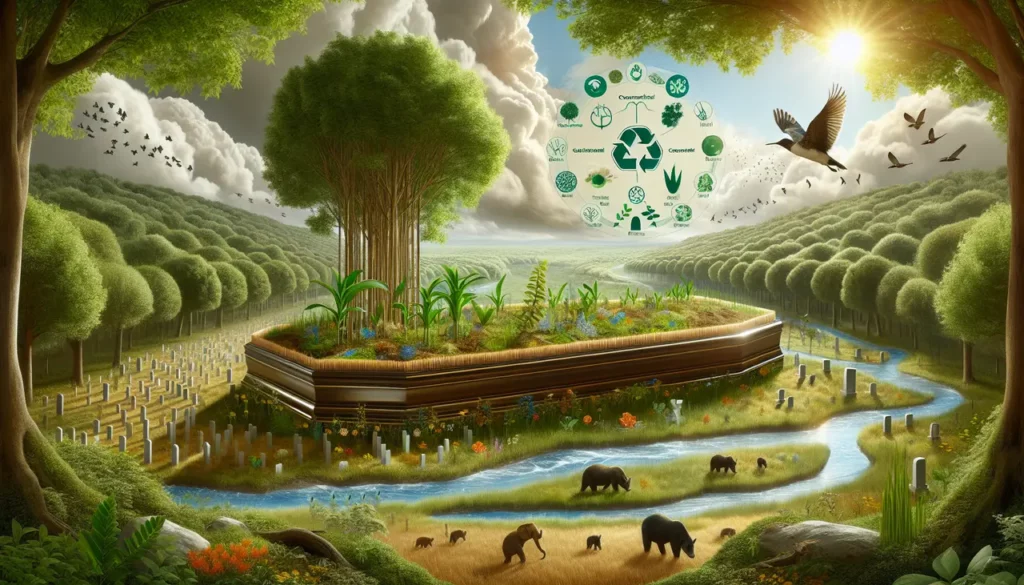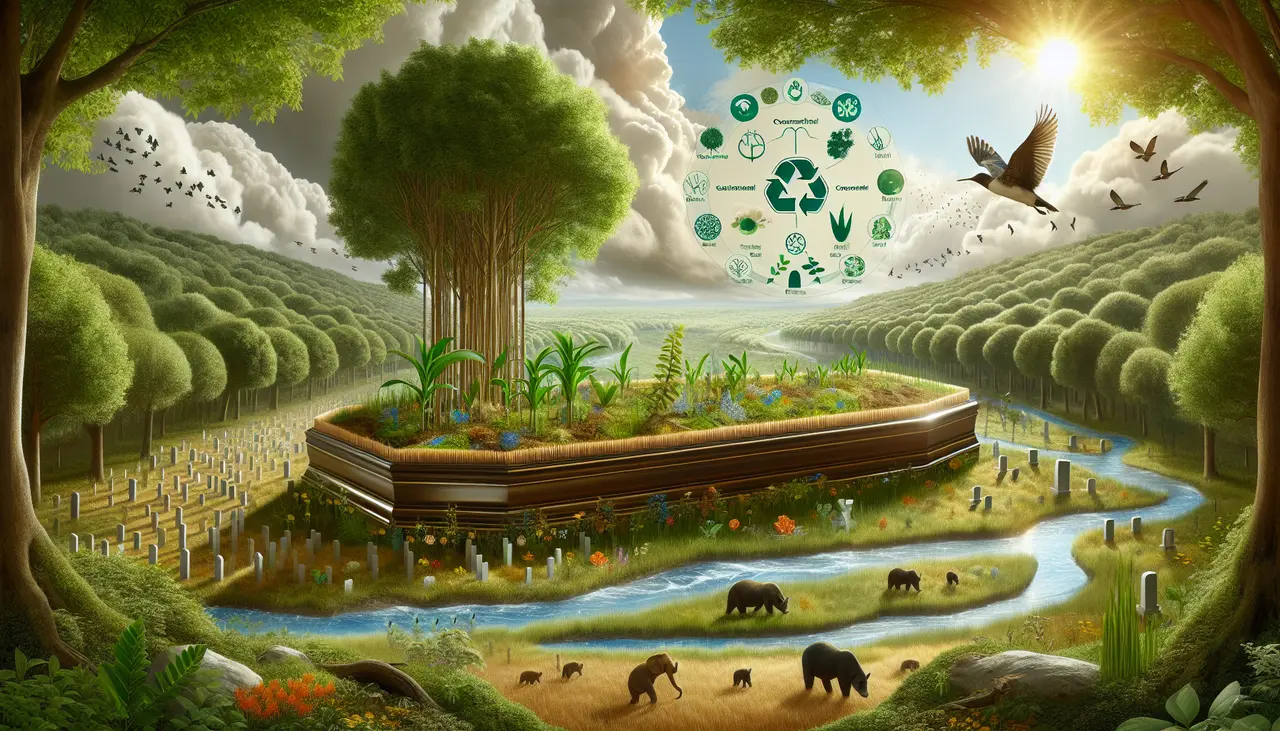Introduction to Green Death Care
Green death care might sound new, but it’s gaining traction for good reasons. Think of it as the eco-friendly cousin of traditional funerals. While standard funerals often involve embalming, metal caskets, and concrete vaults, green funerals opt for simplicity and sustainability. They minimize the environmental footprint left behind when we say our final goodbyes. This means choosing biodegradable materials, foregoing harmful chemicals, and sometimes even planting a tree in honor of the departed. The aim is straightforward: to give back to the earth and reduce harm to the environment in our last acts. So, when we talk about green death care, we’re not just planning for a farewell; we’re making a positive choice for the planet.
Understanding the Environmental Impact of Traditional Burial Practices
Traditional burial practices have a significant environmental footprint, a detail many of us might not consider. Think about it: embalming fluid, a cocktail of chemicals including formaldehyde, methanol, and other solvents, is used in the majority of traditional burials. These substances can leak into the earth, potentially contaminating groundwater. Then, there’s the casket. Often made from metal or rare woods, the manufacturing and transportation of these materials consume vast amounts of resources and energy, contributing to deforestation and carbon emissions. Each year, in the U.S. alone, burials use up approximately 100,000 tons of steel and 1.5 million tons of concrete for vaults. Let’s not forget the land issue; cemeteries occupy vast stretches of land that could otherwise support natural habitats or be used for agriculture. In sum, traditional burial practices are far from green. They demand a considerable amount of resources and have a lasting impact on our planet’s health. This raises a question: could there be a better way? The answer lies in exploring green death care options that are kinder to the environment and just as respectful to our loved ones.
Exploring Green Burial Options
Green burial options are gaining popularity, driven by the desire to reduce the environmental footprint even in death. These methods focus on simplicity and returning the body to the earth in the most natural way possible. Unlike traditional burials, green burials avoid embalming chemicals, metal caskets, and concrete burial vaults. Let’s delve into some of the most common eco-friendly burial choices:
-
Natural Burials: This involves burying the body in a biodegradable coffin or shroud, in a natural setting. The idea is for the body to decompose and become part of the earth again, without hindering the process with non-biodegradable materials.
-
Conservation Burials: Similar to natural burials, conservation burials ensure that the burial site contributes to the preservation of natural habitats. These burials take place in protected lands, supporting ecosystem conservation efforts.
-
Tree or Seed Burials: In this eco-friendly option, a biodegradable urn contains the ashes or even the body, alongside a tree seed. As the urn decomposes, the seed grows into a tree, marking the person’s resting place and contributing to reforestation.
Choosing a green burial is not just a final act of returning to nature; it’s a powerful statement of environmental consciousness. It minimizes the ecological impact, conserves natural resources, and preserves habitats, offering a meaningful and sustainable alternative to traditional burial practices.
The Role of Aquamation in Green Death Care
Aquamation is a key player in the world of green death care, offering an eco-friendly alternative to traditional burial and cremation methods. Also known as alkaline hydrolysis, aquamation uses water and an alkaline solution to break down the body, leaving behind only the bones, which are then pulverized into ash. This method uses significantly less energy compared to cremation, reducing carbon emissions by about 75%. Plus, it doesn’t release harmful mercury emissions into the atmosphere, which can happen during cremation when dental fillings are vaporized. By choosing aquamation, we’re not just opting for a process that’s kinder to the planet; we’re also avoiding the need for caskets and land space that traditional burials require. No embalming fluids or concrete vaults are used, both of which can leach chemicals into the earth. Aquamation represents a gentle return to nature, aligning with a sustainable ethos that honors the environment while respectfully handling our final farewell.
How Natural Burials Promote Ecosystem Growth
Natural burials are about returning the body to the earth in the most eco-friendly way possible. This method skips over the chemicals and metals used in traditional burials, letting the body decompose naturally. Here’s the thing: natural burials can actually boost ecosystem growth. By avoiding embalming fluids and metal caskets, natural burials prevent these harmful substances from leeching into the soil. Instead, the body adds nutrients to the earth as it breaks down. This process can enrich soil health, helping plants and trees to thrive. Additionally, some natural burial sites double as conservation projects. They use the burial fees to fund the protection and restoration of natural areas, turning graveyards into thriving habitats for wildlife. It’s simple, really. Choosing a natural burial means your last act could help rejuvenate a piece of the earth.
Recycling Lives: The Concept of Body Composting
Body composting, or natural organic reduction, turns human remains into soil in a matter of weeks. Unlike traditional burial or cremation, this process emits zero carbon, making it a clear win for the environment. Here’s the dirt on how it works: after death, the body is placed in a vessel with organic materials like wood chips, straw, and alfalfa. Over a few weeks, with the help of oxygen and natural microbes, the body breaks down into nutrient-rich soil that can nourish new life. This method doesn’t just recycle a body; it gives back to the earth, creating a full-circle moment in death. Choosing body composting isn’t just a personal decision but an eco-friendly stance, ensuring a legacy that truly gives back to the planet.
Green Death Care’s Contribution to Carbon Footprint Reduction
Choosing green death care options significantly reduces your carbon footprint, making a positive impact on the environment. Traditional burial methods involve embalming fluids, which contain chemicals harmful to the soil. Cremation, on the other hand, releases carbon dioxide into the atmosphere. Green burials skip these processes, avoiding the release of these pollutants. By opting for a green burial, you’re essentially choosing a method that allows the body to decompose naturally. This reduces the need for non-biodegradable materials like metal caskets and concrete vaults, which traditional burials often require. Additionally, green burials often use biodegradable coffins or shrouds, which further lessens the environmental impact. In summary, green death care practices significantly cut down on the chemicals and materials that harm our planet, making it a thoughtful choice for those conscious of their ecological footprint.
The Cultural and Spiritual Significance of Green Death Care Practices
Green death care practices go beyond environmental benefits; they deeply tie into cultural and spiritual elements for many communities. Choosing green burial or other eco-friendly death care options often reflects a profound respect for the cycle of life. It’s a way to ensure that even in death, a person remains part of the natural world, giving back to the earth that sustained them. This approach resonates with many indigenous and faith-based traditions around the world, where the belief in returning to the earth in as natural a state as possible is a core element of their burial practices. For these groups, green death care is not a new trend but a continuation of long-held spiritual beliefs and cultural rituals. It represents a holistic view of life and death, emphasizing the interconnectedness of humans and the environment. By choosing green death care, individuals often find comfort in the thought that their last act on earth is one of kindness and respect for the planet, aligning with their values and beliefs. This choice can also offer a sense of peace to the bereaved, knowing their loved ones rest in harmony with nature.
Choosing Green Death Care: What You Need to Know
Choosing green death care is about leaving a lighter footprint on the earth even after you pass. It’s simple, really. Traditional burial practices use chemicals and materials that aren’t kind to our planet. Green burial, on the other hand, uses biodegradable materials and skips the chemical embalming, making it a cleaner choice for the environment. Here’s the deal: when you choose a green burial, you’re opting for a casket made of sustainable materials or even a burial shroud that returns to the earth naturally. No concrete vaults, no fancy metal caskets that take forever to break down. It’s about getting back to the basics, letting nature take its course. This choice can also lead to the preservation of natural habitats. Some green burial sites double as protected land, serving as a haven for wildlife and native plants. So, by choosing green death care, you’re not just making a decision for yourself. You’re voting for a healthier planet, fewer chemicals in the soil, and more green spaces for future generations to enjoy. It’s a powerful way to make a final statement about what you value.
Conclusion: The Future of Green Death Care and Its Environmental Benefits
Green death care represents a significant shift towards sustainability in the end-of-life care sector. By choosing eco-friendly burials and cremations, we’re not just honoring the wishes of our loved ones; we’re also making a choice that benefits the earth. The future looks promising for green death care, as society’s awareness grows and more environmentally friendly options become available. Practices such as biodegradable urns, natural burials without chemical preservatives, and conservation burials in nature preserves are gaining traction. These methods significantly reduce carbon footprints, conserve natural resources, and protect the habitats of countless species. As individuals and communities recognize the importance of making eco-conscious choices, the demand for green death care services is expected to rise. This shift could lead to long-term environmental benefits, including reduced pollution and a more respectful interaction with our planet’s ecosystems. Ultimately, embracing green death care not only reflects a respect for the deceased but also conveys a profound commitment to the health and welfare of our planet for future generations.







